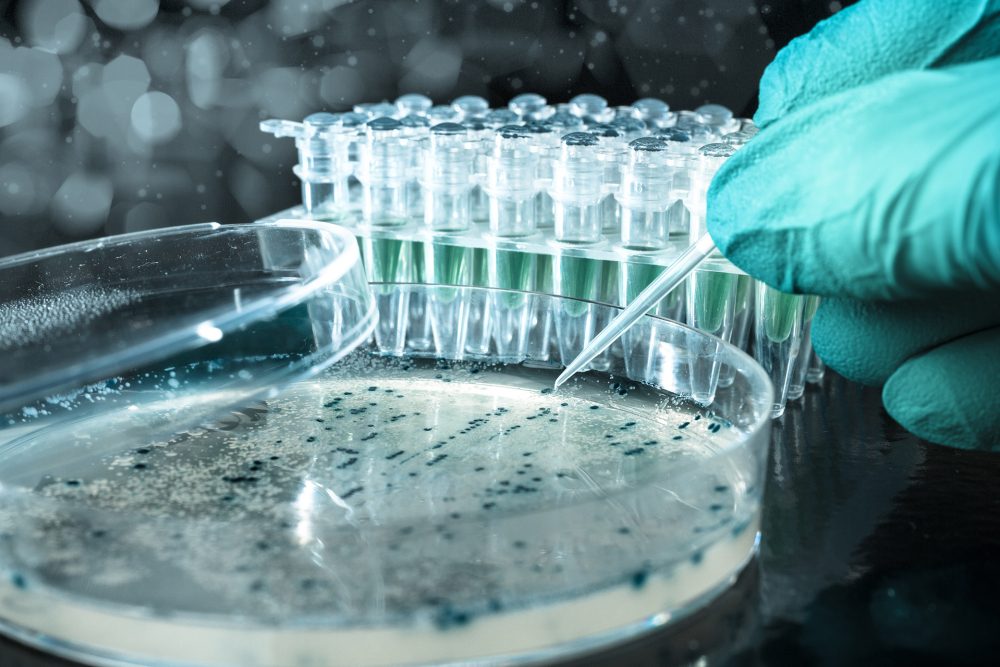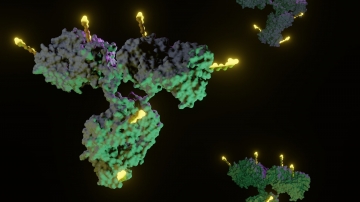Examples of Antibody-drug conjugates
Table of contents
ShowAntibody-drug conjugates (ADCs) are a promising class of targeted cancer therapies that use monoclonal antibodies (mAbs) to selectively deliver potent cytotoxic drugs (cytotoxic agents) to cancer cells. With their ability to reduce systemic toxicity and increase treatment efficacy, these bioconjugates have gained significant attention in oncology – be it in research or the treatment of cancer patients.
In this article, we will discuss different examples of site-specific ADCs, their mechanisms of action, advantages, limitations, and future prospects. We will explore the different types of ADCs and highlight some of the FDA-approved ADCs for clinical use.
The Structure of Antibody-Drug Conjugates (ADCs)
The general structure of an ADC consists of three components: a mAb produced in vitro, a linker, and a cytotoxic payload. The mAb recognizes and binds to a cancer cell antigen, the linker connects the mAb to the cytotoxic payload, and the payload selectively kills cancer cells.
The linker is a critical component of an ADC, as it must be stable in circulation, release the payload upon internalization into cancer cells, and avoid premature release of the payload. Commonly used linkers are disulfide-based and protease-cleavable peptide linkers.

Selecting a cytotoxic payload
The selection of an appropriate cytotoxic payload is critical for the efficacy of an ADC. There are several types of cytotoxic payloads that are commonly used in ADC technology, including maytansinoids, monomethyl auristatin E (MMAE), calicheamicin, duocarmycins, pyrrolobenzodiazepines (PBDs), and others. These payloads differ in their mechanisms of action, half-life and therapeutic index.
Maytansinoids are natural products that inhibit microtubule assembly. They are highly potent and have been used in ADCs such as ado-trastuzumab emtansine (Kadcyla), which is approved for the treatment of HER2-positive breast cancer.
MMAE (but also MMAF) is a synthetic derivative of dolastatin 10, a natural product that inhibits microtubule assembly. MMAE is conjugated to the mAb via a protease-cleavable linker, and it selectively kills rapidly dividing cells by disrupting microtubule dynamics. MMAE has been used in ADCs such as enfortumab vedotin or brentuximab vedotin (Adcetris), which is approved for the treatment of Hodgkin lymphoma and anaplastic large cell lymphoma.
Duocarmycins are DNA-damaging agents that are derived from the natural product CC-1065. They are conjugated to the mAb via a non-cleavable linker and selectively kill cancer cells by alkylating DNA.
Calicheamicin are synthetic molecules that selectively bind to DNA and induce DNA damage. They are highly potent and have been used in ADCs such as gemtuzumab ozogamicin (Mylotarg by Pfizer), which is approved for the treatment of acute myeloid leukemia.
Types of Antibody-drug conjugates
ADCs can be classified based on the type of antibody, linker, and cytotoxic payload.
Antibody Types
ADCs can be created using murine, chimeric, humanized, or fully human antibodies. Murine and chimeric antibodies are less commonly used due to their potential for inducing an immune response in patients.
Linker Types
ADCs can have either cleavable or non-cleavable linkers that connect the antibody and the cytotoxic drug. Cleavable linkers are often preferred as they release the drug within the cancer cell, offering increased efficacy and reduced toxicity towards normal tissue.
Payload Types
ADCs use microtubule inhibitors or DNA-damaging agents as cytotoxic payloads. The choice of payload with a specific antitumor activity depends on the type of target cell and the targeted antigen.
5 Examples of Antibody-drug conjugates
ADCs are a promising treatment option for several cancer types. While many are in the preclinical or clinical development stage or undergoing clinical trials, several ADCs have been approved by regulatory agencies worldwide. Here are some examples of ADCs currently in use:
1. Adcetris (brentuximab vedotin)
Adcetris is an FDA-approved ADC used to treat Hodgkin lymphoma and systemic anaplastic large cell lymphoma. The antibody component of Adcetris targets CD30, which is overexpressed on these types of lymphoma cells. The cytotoxic payload is MMAE, a microtubule inhibitor.
2. Kadcyla (ado-trastuzumab emtansine)
Kadcyla is an FDA-approved ADC used to treat HER2-positive metastatic breast cancer. The antibody component of Kadcyla targets HER2, which is overexpressed in approximately 20% of breast cancers. The anticancer cytotoxic payload used to attack tumor cells is DM1, a microtubule inhibitor and maytansine-derivative that disrupts tubulin polymerization.1 2
3. Polivy (polatuzumab vedotin)
Polivy is an FDA-approved ADC used to treat diffuse large B-cell lymphoma. The antibody component of Polivy targets CD79b, which is overexpressed on these types of lymphoma cells. The cytotoxic payload is MMAE, a microtubule inhibitor. Polivy has shown significant clinical benefit in treating relapsed or refractory diffuse large B-cell lymphoma.
4. Enhertu (fam-trastuzumab deruxtecan-nxki)
Enhertu is an FDA-approved ADC used to treat HER2-positive breast cancer. The antibody component of Enhertu targets HER2, which is overexpressed in approximately 20% of breast cancers. The cytotoxic payload is DXd, a topoisomerase inhibitor. Enhertu has shown promising results in treating patients with HER2-positive breast cancer who have previously received other HER2-targeted therapies.
5. Trodelvy (sacituzumab govitecan-hziy)
Trodelvy is an FDA-approved ADC used to treat triple-negative breast cancer and urothelial cancer. The antibody component of Trodelvy targets Trop-2, which is overexpressed on these types of cancer cells. The cytotoxic payload is SN-38, a topoisomerase inhibitor. Trodelvy has shown significant clinical benefit in treating patients with previously treated metastatic triple-negative breast cancer.3
Mechanisms of Action of Antibody-Drug Conjugates
ADCs work by combining the specificity of antibodies for target antigens with the potency of cytotoxic drugs. The antibody component of an ADC is designed to recognize and bind to a specific antigen on the extracellular space of cancer cells, while the cytotoxic drug component is designed to kill the cancer cells upon lysosomal internalization, i.e. the cytotoxic payload enters the intracellular space through the cell surface.
There are two main pharmacokinetic mechanisms by which ADCs exert their anti-tumor effects.
Antibody-mediated targeting
The first mechanism is antibody-mediated targeting. The antibody component of an ADC (produced via ex vivo synthesis) recognizes and binds to a specific antigen on the surface of cancer cells. This enzyme binding triggers internalization of the ADC into the cancer cell through receptor-mediated endocytosis. Once inside the cell, the cytotoxic drug component is released, leading to cell death.
The specificity of the antibody component for the target antigen is critical for the effectiveness of drug delivery. By selectively targeting cancer cells, ADCs can spare healthy cells and reduce side effects and toxicity, but enhancing tolerability towards the therapy.
Payload-mediated cytotoxicity
The second mechanism is payload-mediated cytotoxicity. Once the cytotoxic drug component of the ADC is released inside the cancer cell, it exerts its toxic effects by various mechanisms, depending on the type of payload.
For example, some payloads, such as tubulin inhibitors, disrupt microtubule formation and prevent cell division. Other payloads, such as DNA-damaging agents, induce DNA damage and trigger apoptosis.
The potency of the cytotoxic drug component is also critical for the effectiveness of the ADC. By delivering high concentrations of cytotoxic drugs directly to cancer cells, ADCs can enhance the anti-tumor effects and overcome resistance.

Challenges and prospects of ADCs
While ADCs offer a promising approach to cancer treatment, there are still some challenges that need to be addressed.
Limited payload capacity – ADCs have limited payload capacity due to the size and stability of the antibody component. This can limit the potency of the cytotoxic payload and reduce the effectiveness of the ADC.
Off-target effects – ADCs can bind to antigens that are not expressed on cancer cells, leading to off-target effects (e.g. neutropenia or the bystander effect) and toxicity. This can limit the therapeutic window and increase the risk of adverse events.
Resistance – Like other cancer therapies, resistance to ADCs can develop over time, leading to treatment failure. This can be due to factors such as reduced antigen expression or mutations that affect the target antigen.
To overcome these challenges, researchers are exploring new strategies for ADC design and development. One area of focus is the development of next-generation payloads, which are small molecule cytotoxic payloads with higher potency and greater stability to increase the effectiveness of ADCs.
Another area of focus is the development of multi-specific and multi-targeted ADCs to increase the specificity and potency of ADCs and reduce off-target effects. Combining ADC regimens with other cancer therapies, such as chemotherapeutic approaches, radiation therapy, or immunotherapy, can enhance the anti-tumor effects and overcome resistance.
Finally, advances in genomic and proteomic profiling are enabling the development of personalized ADCs that target specific mutations or protein expression patterns in individual patients, a strategy known as personalized medicine.
By addressing these challenges and continuing to innovate, ADCs have the potential to transform treatment for cancer and solid tumors and improve outcomes for patients suffering from lymphoma, ovarian cancer, myeloid leukemia and more.
Bringing ADCs even further – with single-use technologies
Antibody-drug conjugates (ADCs) represent a promising class of targeted cancer therapies that combine the specificity of antibodies with the potency of cytotoxic drugs. The clinical success of ADCs such as ado-trastuzumab emtansine (Kadcyla) and brentuximab vedotin (Adcetris) has spurred the development of a growing pipeline of ADC candidates.
However, the development and manufacturing of ADCs present several challenges, including the complexity and variability of the production process, the need for precise control of conjugation chemistry and drug-antibody ratio (DAR), and the potential for immunogenicity and off-target effects. Furthermore, specialized equipment is necessary, e.g. for controlled freezing of ADCs, to maintain product stability and safety of homogeneous ADCs. Additionally, it is vital to protect staff at antibody-drug conjugate companies from being exposed to highly toxic substances, as they are processed during ADC manufacturing.
To address these challenges, new technologies and solutions are emerging in the field of ADC manufacturing. Single Use Support has developed a product line-up based on single-use solutions for bioconjugates. These solutions offer benefits such as reduced risk of contamination, increased flexibility, and improved process control, which can help accelerate ADC development and reduce manufacturing costs, helping to shape the future for this promising class of bioconjugates.
- Antibody–Drug Conjugates: A Comprehensive Review, http://dx.doi.org/10.1158/1541-7786.MCR-19-0582, Published 2019-10-28
- Breast Cancer HER2 Status, https://www.cancer.org/cancer/breast-cancer/understanding-a-breast-cancer-diagnosis/breast-cancer-her2-status.html, Published
- Trodelvy (Sacituzumab Govitecan), https://www.ema.europa.eu/en/documents/overview/trodelvy-epar-medicine-overview_de.pdf, Published 2021










